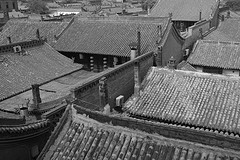Searching for Pingyao
When non-Chinese imagine what China is like, a typical image that emerges is that of a small, traditional village, with narrow alleys and houses of tiled, curved roofs, with watchtowers and city walls and streets lit by lanterns. When they visit China, what they often get instead are monstrous, polluted and skyscraper-laden cities like Beijing, whose population (estimates are between 14 million and 22 million) may be higher than that of the entirety of Australia. Even smaller cites like Xi’an and Qingdao, both of which I visited in the past two weeks, have about eight million inhabitants each and are enormous by the standards of nearly every other country on earth. When you walk along a ring road in one of these places and look up at flyovers, grey skies and congested traffic, the idealistic Chinese village seems far away.

Ironically, it’s in one of the symbols of China’s massive modernisation in recent decades – the Beijing subway – that the image of the Chinese village was rekindled for me; in some of the stations, there are enticing photos on the walls of a place called Pingyao, whose old-world charm seemed almost out of place in the new China. When I looked it up on a map and saw it was between Xi’an and Beijing, we quickly added it to the itinerary of this week’s trip.
We arrived in Pingyao on Tuesday morning on the overnight train from Xi’an, and the difference between the two places could hardly be greater. Pingyao, along with Lijiang in Yunnan province, is considered one of the two best-preserved historic walled towns in China, and you could instantly sense why. The town is surrounded by an impressive set of AD 1370 city walls containing 72 watchtowers, and inside the walls – where cars are (mostly) banished and traditional Chinese residential architecture is abundant – it can often seem like centuries ago. Even relics of a previous age, defensive spiked mechanisms, remain displayed near the city walls as though ready to strike down modern-day invaders who would seek to disrupt Pingyao’s charm.
We spent a couple of relaxing days wandering around town, walking on top of the city walls and climbing the city tower in the middle of the old town for a fabulous view over the rooftops of Pingyao. While walking around, we noticed that outside a few of the shops on one of the bustling pedestrian thoroughfares, bronze pots of water with shiny handles sit idle on the street. For two days we wondered about these, curiously watching as every now and then someone rubbed both handles. When we asked a local what it meant, she said people do it all the time but that it doesn’t have any significance at all – and that’s the sort of timelessness that defines Pingyao.
The place was so peaceful and relaxing, we could have gladly stayed a few more days. But Pingyao is not the only place in Shanxi province worth visiting, and one of the great historic sites in all of China beckoned.
Tags: Asia, China, Pingyao, traditional, Travel, village, walls

Your travel journey is really interesting- I’ve never been to China so you enable me a little taste of it through your eyes.
How To Make Not Traveling Fun
Sometimes you just can’t go to all the places you dream of, or at least can’t go to all the places you dream of when you want so the really best you can do is read the stories of people that are doing the trip you dream of.
Personally I li…